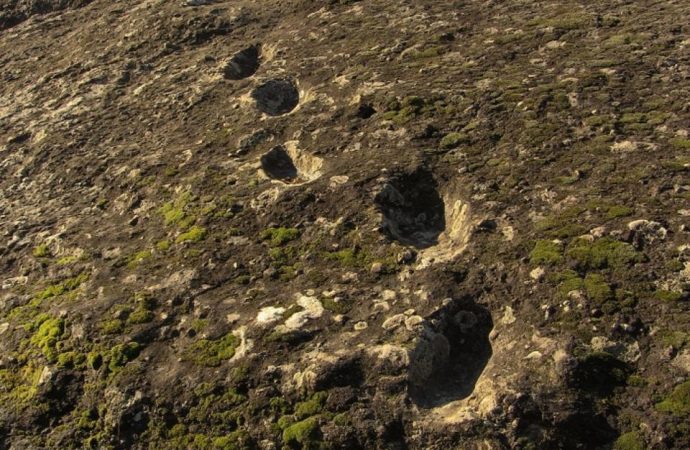Local people called them “Ciampate del Diavolo” or the devil’s trail, as only a supernatural entity could leave its footprints in apparent solid rocks. Discovered in 2001, for archaeologists the devil’s trails site near the Italian town of Roccamonfina is a rare example of humanoid footprints preserved in volcanic rocks.
Source: Forbes
Some 50,000 years ago the hill of Roccamonfina, a stratovolcano with a radius of about 10 kilometer (10 miles) located along the northern Campania coast in modern Italy, at a distance of about 60 kilometer to the northwest of the more famous Somma–Vesuvius complex, erupted violently, covering the landscape with volcanic ash and debris. Various hoofed animals and a group of hominids walked over the volcanic deposits, leaving their hoof- and footprints in the still soft material.
A team of Italian archaeologists and geologists analyzed in more detail the preserved trackways, discovering that the footprints were likely made just a few hours or days after a violent volcanic explosion send pyroclastic flows down the slopes of the Roccamonfina volcano. Likely volcanic activity was still ongoing when the volcano was visited by a group of – maybe curious – hominids. The research is published as open access paper in the Journal of Quaternary Science.
Fresh deposits of a pyroclastic flow exceed temperatures of 300°C, making it impossible to walk (or drive) over such terrain. Depending on the thickness of the layer, the volcanic material cools down in a matter of hours or days. As the material cools down, new minerals form between the debris, solidifying and hardening the loose material. Based on the observed step length and depth of the footprints, the archaeologists conclude that the volcanic material was still soft and yet cool enough to allow for slow and regular walking by the hominids, likely not exceeding a temperature of 50°C. The trackways were left by a group following the slope of the mountain, walking at a speed of 1 meter/second (3ft/s), generally regarded as a normal speed for a walking person in no hurry. Apparently, the still active volcano was of no real concern to the visitors. One trackway is oriented in an opposite direction with respect to the others, maybe implying that this path was followed by different people at different points in times after the eruption. The discovery of rock artefacts nearby also supports the notion that the site was repeatedly visited, maybe to get volcanic rocks for new stone tools.
Considering the age of the volcanic rocks the researchers think the footprints were left by early hominids, most likely Neanderthals, known to inhabit the Italian peninsula at the time from other archaeological sites.
Source: Forbes

































Leave a Comment
You must be logged in to post a comment.